Turning your outdoor area into a stunning space is easy with the right decor. Decorative garden rock features are a hit for adding beauty and keeping things simple. They’re perfect for garden design without the fuss.
Decorative rocks can make your garden look amazing. You can use them to make paths or highlight special spots. They’re great for making your garden unique, whether you’re updating or starting fresh. Decorative garden rock is a smart choice for any garden.
Key Takeaways
- Decorative garden rock features offer a low-maintenance garden design solution.
- Incorporating decorative rocks can enhance your garden’s aesthetic appeal.
- These features allow for creative expression in garden design.
- They can be used to create pathways or focal points in your garden.
- Decorative garden rock is versatile and suitable for various garden styles.
The Beauty and Benefits of Garden Rocks
Garden rocks are a great way to make your outdoor space look good without much work. They bring natural beauty to your garden. This makes your landscape look good and easy to care for.
Aesthetic Appeal of Natural Elements
Adding garden rocks to your garden adds a natural beauty. The different textures and colours of the rocks match your garden well. This creates a balanced and beautiful look.
- Natural stone elements can be used to create a focal point in your garden.
- The texture and colour of the rocks can enhance the overall aesthetic appeal of your outdoor space.
Practical Advantages for Garden Maintenance
Garden rocks are not just pretty; they’re also practical. They help stop weeds, keep the soil moist, and control the soil’s temperature.
Key benefits include:
- Reduced weed growth
- Improved soil moisture retention
- Regulated soil temperature
Environmental Benefits for UK Gardens
In the UK, garden rocks help make gardens better for the environment. Using local stone cuts down on carbon emissions from transport.
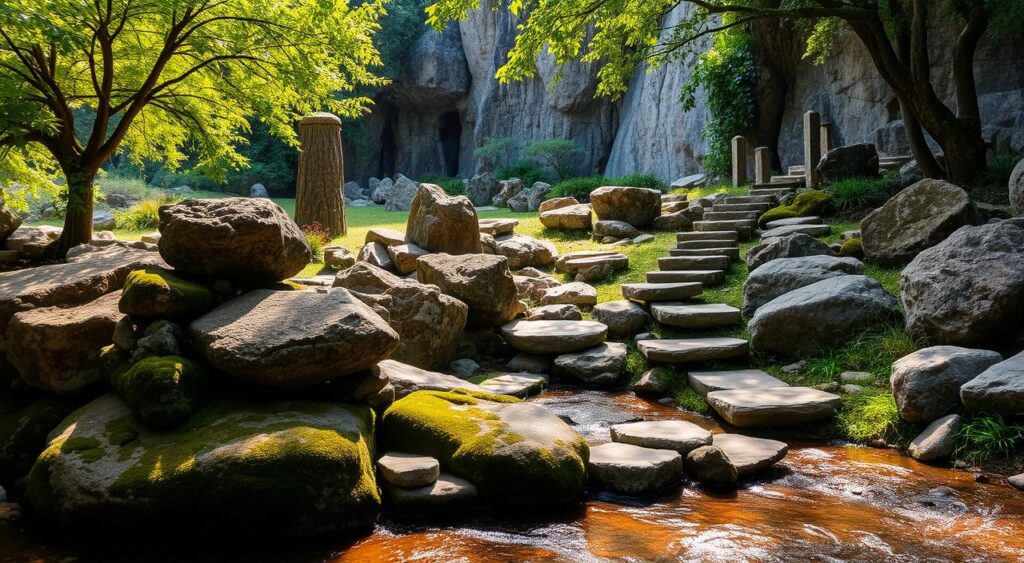
They also help local wildlife, like insects and small animals. This boosts biodiversity in your garden.
Types of Decorative Garden Rock for British Landscapes
Decorative garden rocks come in many types, each with its own benefits for British gardens. You can pick from a wide range to make your garden both stunning and useful.
Pebbles and Gravel Options
Pebbles and gravel are great for decorating gardens because they’re versatile and look good. They come in different sizes and colours, making it easy to match them to your garden’s design. Pebbles are small, rounded stones that look nice on pathways or as ground cover. Gravel is smaller, angular stones that help with drainage and are easy to maintain.

Boulders and Statement Rocks
For a bold look, use boulders or statement rocks in your garden. These big rocks can be focal points, adding depth and character. You can place them alone or in groups to make a natural landscape feature.
Specialty Stones
Specialty stones like Cotswold, Yorkshire, and Welsh Slate have unique features that can improve your garden’s look. These local stones can add a regional touch to your garden design.
Local Stone Varieties
Using local stones makes your garden fit in with the area. For example, Cotswold stone has warm tones, while Yorkshire stone has earthy colours.
Imported Stone Options
Imported stones offer more colours and textures, adding variety to your garden design. They can make your garden more interesting and diverse.
| Stone Type | Characteristics | Best Use |
|---|---|---|
| Pebbles | Small, rounded, various colours | Pathways, ground cover |
| Gravel | Small, angular, good drainage | Low-maintenance ground cover |
| Boulders | Large, dramatic, naturalistic | Focal points, landscape features |
Choosing the right decorative garden rock can make your outdoor space more beautiful and functional. It will enhance your garden and match the British landscape.
Planning Your Rock Garden Design
To make your outdoor space better, start with a good design plan. Look at your garden’s special conditions and make a design that fits well with your landscaping.
Assessing Your Space and UK Climate Considerations
First, check the area for your rock garden. Think about sunlight, soil, and drainage. The UK’s weather can change a lot, so pick rocks and plants that fit your local weather.
Creating a Cohesive Design Plan
A good design plan is key for a beautiful rock garden. Think about the look you want and how it will fit with your garden.
Sketching Your Layout
Start with a simple sketch of your design. It doesn’t need to be perfect, but it should show where rocks and plants will go.
Using Digital Design Tools
For a clearer idea, try digital design tools. They let you try different layouts and see your garden before you start.
Complementing Existing Landscaping
Make sure your rock garden goes well with your garden. Pick rocks and plants that improve your outdoor look and balance with your garden.

Essential Tools and Materials for Rock Feature Installation
To make your garden rock feature ideas real, you need the right tools and supplies. Installing decorative stones is a fun DIY task. But, it needs careful planning and the correct tools.
Basic Equipment Checklist
Before you start, make sure you have these basic tools:
- Shovel and Trowel: For digging and moving rocks and soil.
- Rake: To level the ground and spread gravel or sand.
- Wheelbarrow: For carrying heavy loads of rocks, soil, or gravel.
- Spirit Level: To check your rock features are straight.

Safety Considerations
When working with heavy stuff, safety comes first. Wear protective gloves to avoid injuries. Also, use safety goggles when you’re breaking or drilling rocks.
“Safety is not just a precaution, it’s a necessity when working on garden projects.”
Calculating Material Quantities
It’s important to calculate how much material you need. Measure your garden and decide on the rock layer depth. Usually, 2-3 inches of rock is enough for most installations.
UK Suppliers and Resources
For top-quality decorative stones and garden rock features, look at UK suppliers. They have a wide range of materials and can give you expert advice to help you succeed.
Step-by-Step Guide to Installing Decorative Garden Rock Features
Installing decorative garden rock features is easy and can make your outdoor space look great. Just follow a few simple steps to create a stunning rock garden. It will match your current landscaping perfectly.
Preparing the Ground
To start, clear the area of debris, weeds, and plants. Make sure the ground is level to avoid water pooling. If your soil is clay or sand, mix in some amendments to help with drainage.
Laying Weed Barrier and Drainage
Then, put down a weed barrier fabric to stop weeds. This step is vital for keeping your rock garden weed-free. Also, think about adding a drainage system to stop water from pooling. Good drainage is essential for keeping your rocks stable.
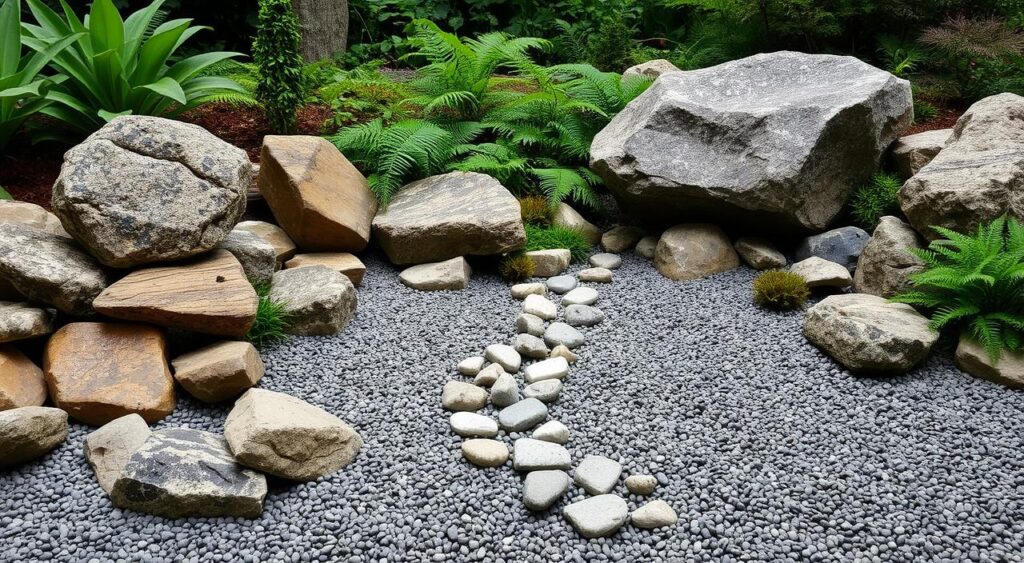
Positioning and Securing Rocks
With the ground ready and weed barrier in place, start placing your rocks. Begin with the biggest rocks, as they’ll be the main focus. Use a spirit level to make sure they’re balanced. For big rocks, dig a shallow hole to hold them in place.
Adding Finishing Touches
Once your rocks are in, add gravel or pebbles to fill gaps. This makes your garden look better and helps with water flow. Don’t forget to add plants that fit well in rock gardens for color and texture.
Working with Different Soil Types
When dealing with different soils, adjust your approach. For clay soil, add more drainage to avoid waterlogging. In sandy soil, mix in organic matter to hold water better.
Creative Decorative Garden Rock Ideas for Different Garden Styles
Decorative garden rocks can make your garden look amazing. They fit well in many garden styles. You can use them in calm, natural gardens or in modern, simple ones.
Japanese Zen Gardens
Japanese Zen gardens are peaceful and simple. You can make a calm space with decorative garden rocks. Arrange them in a nice pattern with raked gravel or sand. This helps with mindfulness and meditation.
Mediterranean-Inspired Designs
Mediterranean gardens are bright and rustic. Decorative garden rocks can be used for paths or as ground cover. They match the lush plants and terracotta pots well.
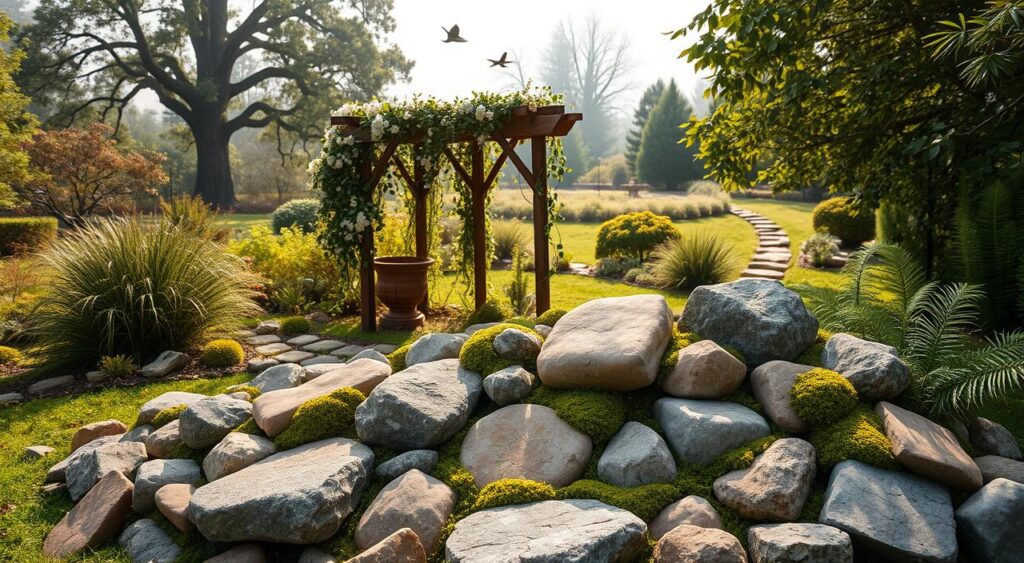
Contemporary Minimalist Approaches
For a modern minimalist garden, use decorative garden rocks to keep it clean. Place big rocks or boulders among few plants. This creates a strong contrast.
Traditional British Cottage Garden Rock Accents
Traditional British cottage gardens are warm and welcoming. Decorative garden rocks add texture and interest. Use them for rock borders or accents around plants and paths.
| Garden Style | Characteristics | Use of Decorative Garden Rocks |
|---|---|---|
| Japanese Zen | Serene, simple, natural | Arranged in harmonious patterns, often with raked gravel |
| Mediterranean-Inspired | Vibrant, rustic, lush | Used for pathways or as ground cover, complementing vegetation |
| Contemporary Minimalist | Clean, uncluttered, modern | Strategically placed large rocks or boulders among sparse vegetation |
| Traditional British Cottage | Cozy, inviting, textured | Used to create rock borders or accents around plants and pathways |
Decorative garden rocks can make your garden more beautiful and useful. They work well in many garden styles.
Combining Plants and Rocks for Year-Round Interest
Mixing plants and rocks can turn your outdoor area into a year-round beauty. Pick the right plants and rocks to make a stunning garden feature.
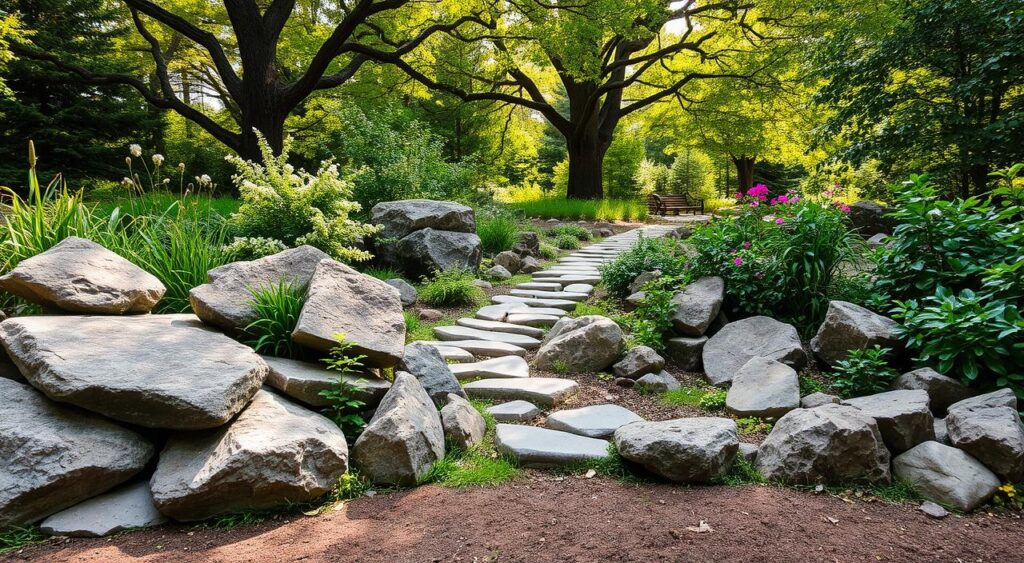
Best Plants for Rock Gardens in the UK Climate
Choosing the right plants for your rock garden is key. Native UK alpine and rock garden plants are great because they’re hardy and grow well in rocky spots.
Native UK Alpine and Rock Garden Plants
Top native UK plants for rock gardens include Saxifraga, Armeria, and Thymus. They’re not just pretty but also tough, adding interest all year.
Creating Attractive Plant and Rock Combinations
To make a great plant and rock mix, think about color, texture, and size. For example, smooth pebbles look good with delicate plants like Dianthus.
Seasonal Planting Considerations
Think about the seasons when planning your rock garden. Pick plants that look good all year. Spring bulbs like Crocus and Galanthus add color early, while Phlox and Sedum bloom later.
By choosing the right plants and rocks, and thinking about the seasons, you can make a rock garden that’s beautiful all year.
Water Features with Decorative Garden Rock
You can make your garden a stunning oasis by mixing decorative garden rock with water features. This mix not only makes your outdoor area look better but also makes it more relaxing.
Creating Rock Streams and Waterfalls
Rock streams and waterfalls bring excitement to your garden. By picking the right decorative stones, you can make a water flow that looks natural and fits your garden’s look.
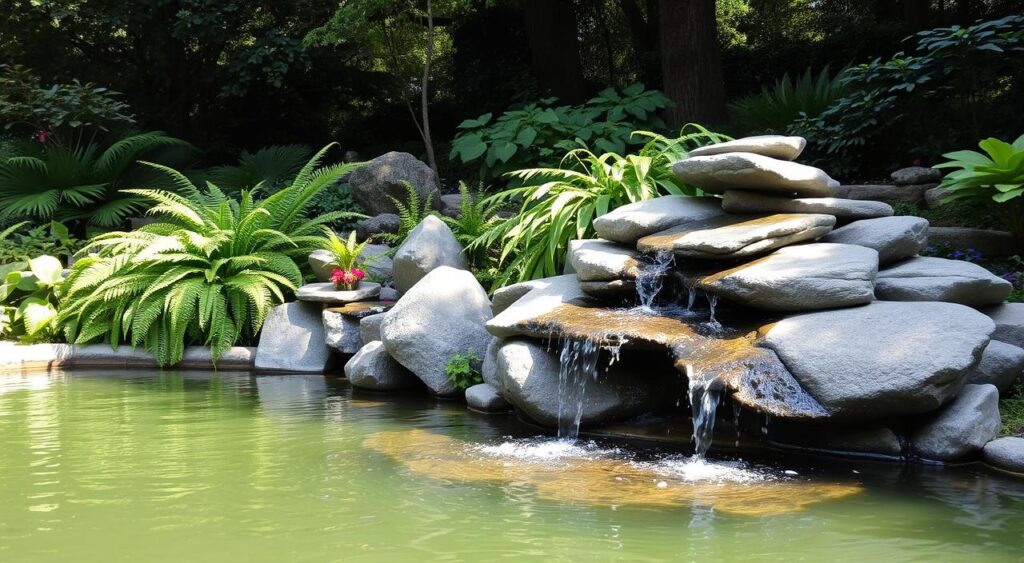
Designing Rock-Bordered Ponds
Rock-bordered ponds are calm and stylish. Using decorative garden rock around the pond makes the water and the garden blend smoothly.
Low-Maintenance Water Feature Options
If you want a water feature that’s easy to care for, think about a self-circulating pond or a solar-powered fountain. These options don’t need much work and are good for the planet.
UK Weather Considerations
When you design water features with decorative garden rock in the UK, think about the weather. Make sure your water feature can handle frost and heavy rain to stay in good shape all year.
Maintaining Your Rock Garden Throughout British Seasons
To keep your rock garden looking its best, it’s essential to understand the seasonal maintenance needs. A well-planned maintenance routine will ensure your garden remains a beautiful and tranquil oasis throughout the year.
Seasonal Maintenance Calendar
Regular maintenance is key to a thriving rock garden. Here’s a brief overview of what to focus on each season:
- Spring: Clean up debris, inspect plants, and replenish gravel or mulch as needed.
- Summer: Monitor for weeds, ensure proper drainage, and maintain plant health.
- Autumn: Clear fallen leaves, prepare plants for winter, and inspect rock features for damage.
- Winter: Protect plants from extreme cold, prevent ice damage to rock features, and keep pathways clear.
Dealing with Weeds, Moss, and Algae
Weeds, moss, and algae can be a nuisance in rock gardens. Regularly inspect your garden and use appropriate control methods, such as manual removal or targeted herbicides.
Refreshing and Updating Your Rock Features
Periodically refresh your rock garden by rearranging or adding new rocks, and updating plantings to keep the garden looking vibrant.
Winter Protection Techniques
Protect your rock garden during harsh winters by covering sensitive plants, securing loose rocks, and ensuring drainage systems are clear.
| Season | Maintenance Tasks |
|---|---|
| Spring | Clean debris, inspect plants, replenish gravel |
| Summer | Monitor weeds, ensure drainage, maintain plant health |
| Autumn | Clear leaves, prepare plants for winter, inspect rock features |
| Winter | Protect plants, prevent ice damage, keep pathways clear |
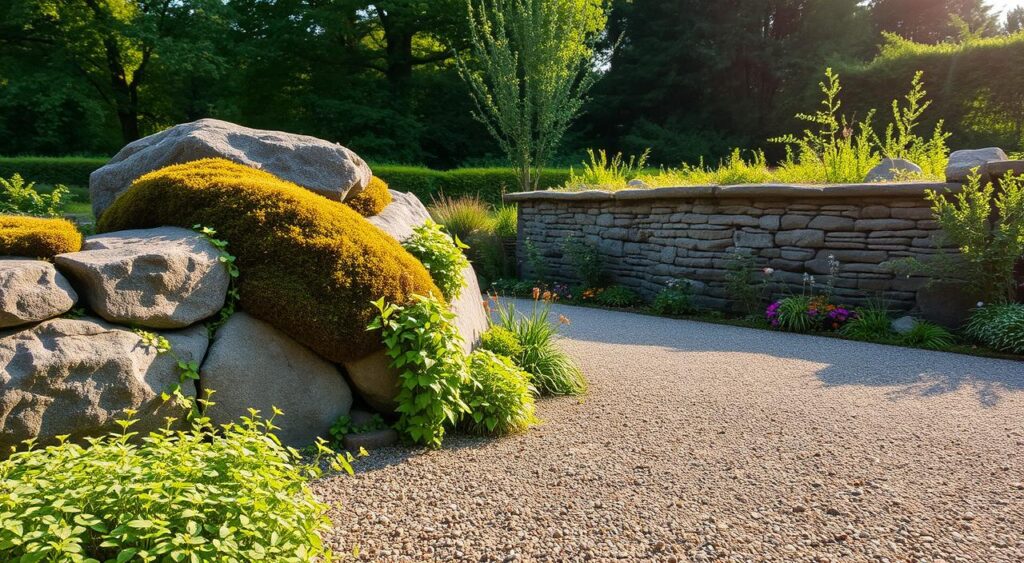
Budget-Friendly Decorative Garden Rock Ideas
With a bit of creativity, you can make a decorative garden rock feature on a budget. You don’t have to spend a lot to beautify your outdoor space with decorative garden rocks. Here are some affordable ideas to start with.
Sourcing Affordable Materials in the UK
Save money by looking for materials locally. You can find cheap decorative rocks at garden centres, landscaping suppliers, or online. Look for materials that are in season or slightly used to save even more.
DIY Rock Feature Projects
Doing it yourself can cut costs. You can make your own rock garden by using what you already have or reclaimed stone. Online tutorials and gardening forums are great for tips and ideas.
Phased Implementation Approaches
Doing your rock garden in stages can help manage costs. Start small and grow as your budget increases. This way, you can change your design as you go.
Reclaimed and Recycled Stone Options
Using reclaimed or recycled stone is cheap and good for the planet. You can find it at salvage yards or online. It adds charm to your garden and helps reduce waste.
| Material | Cost-Effective Option | Environmental Benefit |
|---|---|---|
| Reclaimed Stone | Yes, reduces waste | High, reuses existing materials |
| Locally Sourced Gravel | Yes, reduces transport costs | Medium, depends on sourcing practices |
| Recycled Decorative Rocks | Yes, cheaper than new rocks | High, reduces demand for new materials |
By using these budget-friendly tips, you can create a stunning decorative garden rock feature. It will enhance your outdoor space without costing a lot.
Conclusion: Transforming Your Outdoor Space with Natural Stone Elements
You now know how to make your outdoor area beautiful and useful with decorative garden rocks. Adding natural stone to your garden can make it look better and be more eco-friendly.
Decorative garden rocks can make any garden, from Japanese Zen to traditional British, look amazing. They add texture and interest. Mixing rocks with plants and water features makes your outdoor space truly special.
Think about the benefits of your garden design, like it being easy to care for and good for the environment. With some planning and creativity, you can turn your outdoor space into a beautiful and useful area. It will make your home look better and improve your outdoor time.


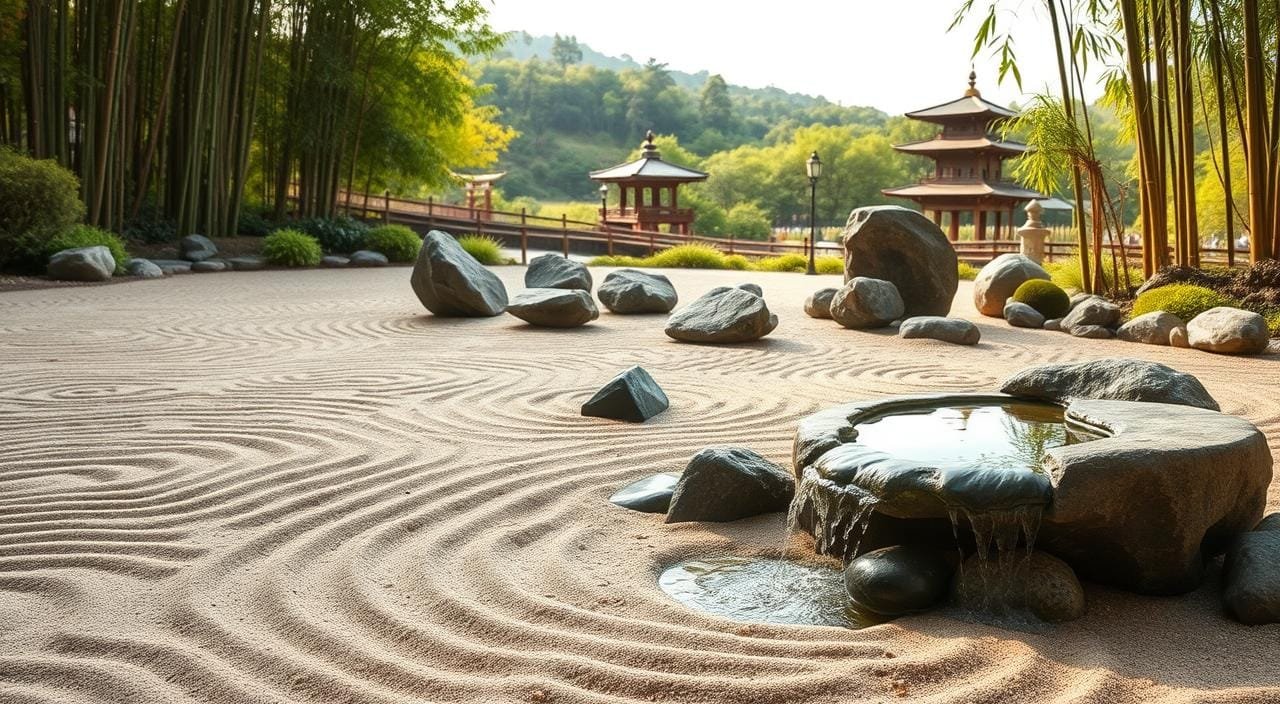


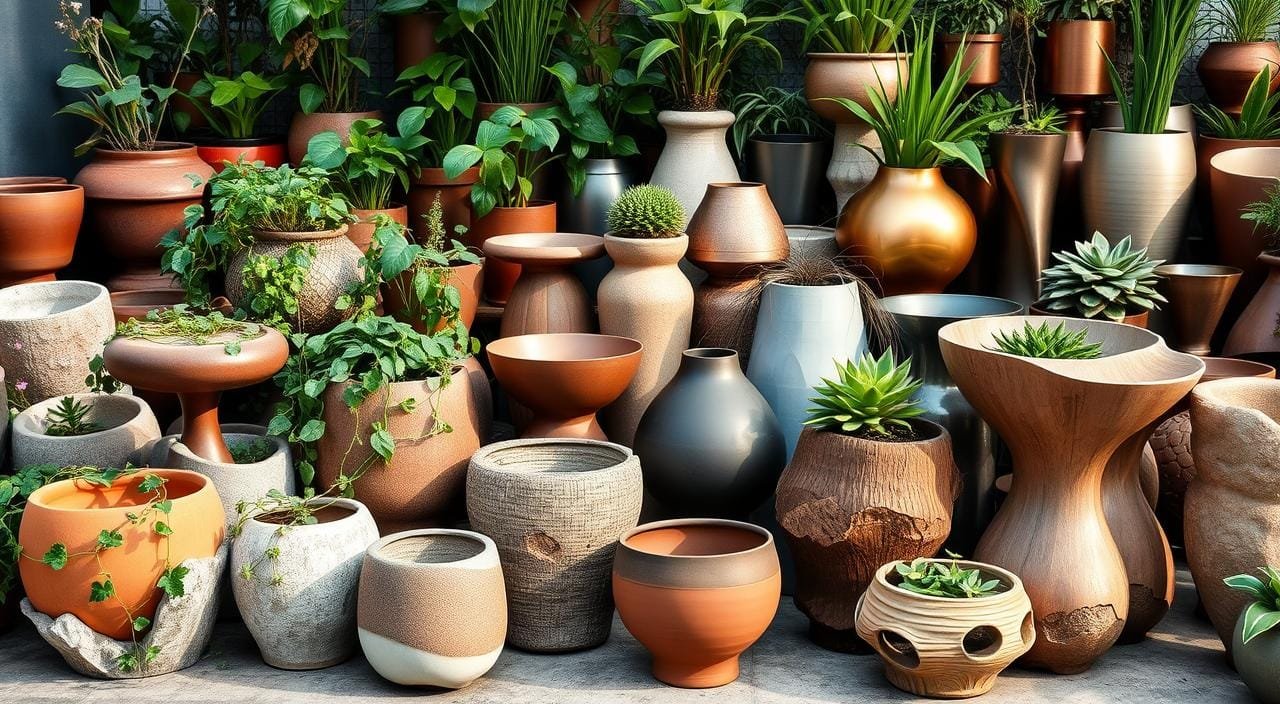
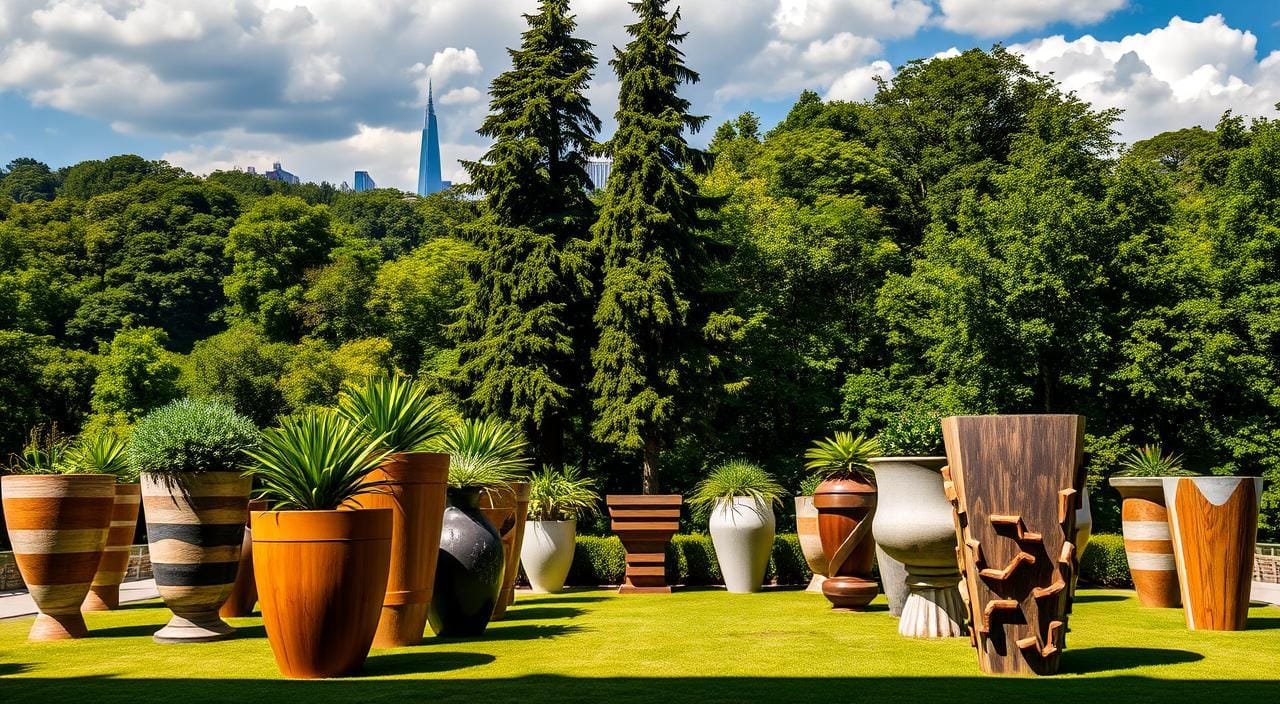

Leave a Comment